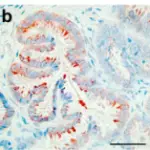Transitional cell tumors of the ovary resemble urothelium rather than ovarian surface epithelium, described as a primary ovarian carcinoma in which definite urothelial features are present, but no benign, metaplastic and/or proliferating.
What is the Pathology of Transitional Cell Tumors of the Ovary?
The pathology of transitional cell tumors of the ovary is:
-Etiology: The cause of transitional cell tumors of the ovary is unknown.
-Genes involved: UPK3A gene.
-Pathogenesis: The sequence of events that lead to transitional cell tumors of the ovary is malignant proliferation.
-Morphology: The morphology associated with transitional cell tumors of the ovary shows papillary structures with a fibro-vascular core, covered by a transitional epithelium, and the absence of stromal infiltration.
-Histology: The histology associated with transitional cell tumors of the ovary shows malignant cells.
How does Transitional Cell Tumors of the Ovary Present?
Patients with transitional cell tumors of the ovary typically females of any age but most predominantly in 30-70 years of age. The symptoms, features, and clinical findings associated with transitional cell tumors of the ovary include: no symptoms if tumor is small. The larger tumors show abdominal pain, abdominal swelling or distension, uterine bleeding, back pain, bowel or urinary symptoms, and weight loss.
How is Transitional Cell Tumors of the Ovary Diagnosed?
Transitional cell tumors of the ovary is diagnosed by: physical examination, Microscopic examination, abdominal ultrasound, MRI, blood tests for CA72-4 and CA125 levels.
How is Transitional Cell Tumors of the Ovary Treated?
Transitional cell tumors of the ovary is treated by: surgical resectability, cisplatin-based chemotherapy.
What is the Prognosis of Transitional Cell Tumors of the Ovary?
The prognosis of transitional cell tumors of the ovary is better. The predominance of these tumors has a favorable prognostic factor and patients with higher clinical stages has poorer prognoses.



